Process engineering – the basis of the entire process industry
A comprehensive overview of the process technology that transforms raw materials into versatile products.
Definition – What is process engineering?
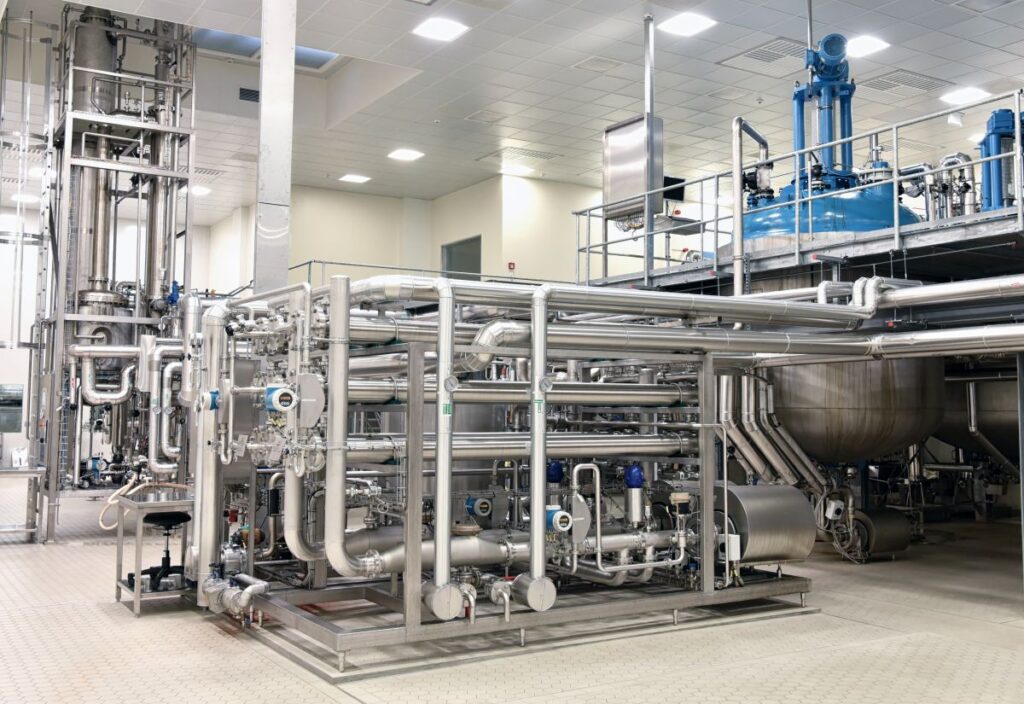
The production of food, medicines, chemical products and many other materials would not be possible to the extent required today without modern process engineering. This involves the economically viable modification of raw materials through technical processes to create a new product. The type and composition of different raw materials are changed in such a way that they subsequently have different properties than before. As these material changes are based on scientific principles, experts often refer to process engineering as a bridge between production and science.
Areas of application – Where is process engineering used?
The most important areas of application include some of the most important sectors of the modern manufacturing industry:
- Food industry
- Chemical industry
- Pharmaceutical industry
- Paper industry
- Textile industry
- Building materials industry
- Waste management
- Metal processing
Overview of the development of process engineering
Process engineers use various engineering tools to achieve the required goals. Among other things, they determine the appropriate spatial and manufacturing conditions to be used for the respective process. The required machines are manufactured by mechanical or civil engineers who follow the process engineer’s specifications. In disciplinary terms, process engineering is part of mechanical engineering, as it utilises elements of manufacturing, energy and production technology to change form and/or convert energy. Separate areas are chemical engineering and environmental engineering, both of which have become increasingly important in recent decades.
Historical review of modern process engineering
Process engineering, in its essence, is almost as ancient as humankind itself. In principle, the use of fire is nothing more than the transformation of naturally occurring substances to set a desired process in motion. Beyond preparing food, early humans quickly came up with the idea of using the firing process to make clay vessels more durable. Even today, archaeologists still find ceramic vessels (or at least parts of them) made in early times.
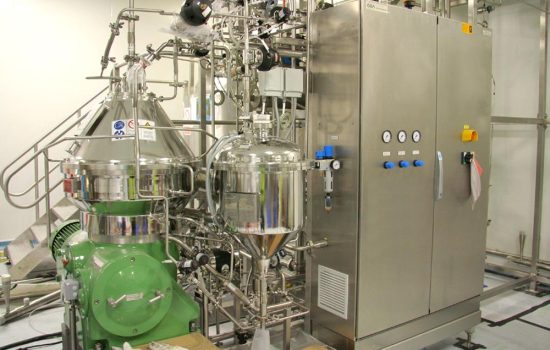
Simply give us a call ( +49 2841 91840 )
or use our contact form
The importance of fire in process engineering
In the next step, people used fire for the first time to extract pure metals from ores by applying heat. From around 6000 BC, the first high-quality weapons and consumer goods were made from metal, marking the beginning of the Bronze Age. However, early processes were also used to change the material properties of food. Around the same time in Babylonia, for example, it was discovered that alcoholic drinks could be produced using fermentation processes. The production of cheese is also one of the processes used to transform substances. Fermentation and fermenting often went hand in hand. During fermentation, substances are refined. This is achieved by adding microorganisms or cells of animal origin. Last but not least, the filtration of substances or the evaporation of water to obtain salt are also variants of process engineering. From here, it was not far to the discovery of distillation, for example, to increase the alcohol content of drinks. By utilising water power and wind power, mills finally succeeded in considerably simplifying the processing of grain into flour and subsequently into the end product, bread.
Process engineering and the industrial revolution
In the course of the industrial revolution, process engineering was able to break new ground. Larger quantities of raw materials could be converted faster and in better quality. This reduced manufacturing costs. As a result, many things became more affordable for the general population, increasing prosperity and quality of life. Factories were equipped with large processing plants to manufacture a wide variety of products efficiently. The steam engine, invented in 1712, was a real game changer in this respect, as mechanical energy and heat could be utilised on a large scale for a wide variety of processes for the first time.
Progress through industrial production
In the following two centuries, many new industries emerged that could bring completely new products onto the market thanks to the mechanisation of work. For example, the industrial production of steel and other metals made building railways or gigantic ship propulsion systems possible. Shorter transport times and greater independence from wind and weather meant more goods could reach a greater number of consumers in less time. Using electricity also opened up new possibilities for logistics and process handling. Electricity generators eventually produced light and mechanical energy around the clock to power machines and appliances, supplementing and ultimately replacing the steam engine.
Improving care for socially disadvantaged population groups
Mechanical looms revolutionised textile production as early as 1785. Large facilities, in which fabrics could be processed faster, more cheaply and with consistent quality, made the industrial production of raw materials very profitable for textile manufacturers. Falling prices also made it possible to improve the supply of affordable clothing to less affluent sections of society. Production lines and assembly lines were introduced on an industrial scale as early as the end of the 19th century. However, assembly line production had its breakthrough in the 20th century in the automotive industry, when Henry Ford no longer had his models produced in elaborate one-off production and thus promoted mass mobility. Assembly lines proved to be the perfect solution for optimised material flow and increased production in many branches of industry. These inventions continue to play a major role in the design of process engineering plants.
Milestones in process engineering
One of the most important innovations closely linked to the success of the automobile was certainly the industrial processing of crude oil. By converting this raw material into its various hydrocarbon fractions, not only were high-quality lubricants obtained, but also fuels such as petrol or diesel. Standardised lamp oil replaced expensive whale oil and quickly made the large whaling industry redundant. More efficient combustion engines closed the gap between electric and large steam engines, ultimately making way for more efficient drives in the railway and shipbuilding industries. However, has also been indispensable in chemical and medical research. The production of artificial fertilisers has significantly contributed to ensuring that food production has kept pace with the constantly growing population – at least in industrialised countries. The possibilities offered by organic chemistry for the development of medicines or the production of plastics would be inconceivable without modern process engineering facilities.
Technical basics of process engineering
The difference between machines and appliances
Due to the large number of application areas, the basic processes are organised into different main groups based on the respective scientific laws. This means that physical, chemical or biological processes can be assigned to each process. It is common, for example, to categorise physical processes into mechanical, thermal, electrical or electromagnetic areas. A distinction is also made between machines and apparatus where the respective material conversion occurs. While machines generally contain moving and driven parts, chemical, biological or energetic processes occur in apparatus without the inclusion of driven parts.
Examples of basic procedures:
Reaction – chemical or biological process
Association – physical-mechanical processes
Separation – physical-thermal or mechanical processes
Division – physical-mechanical processes
Heat transfer: physical-thermal processes
Storage, conveying, etc.: physical-mechanical or electromagnetic processes
Nowadays, mechanical and thermal processes are increasingly classified into areas for solids and fluids. Accordingly, the classification of basic chemical and biological processes is based on the type of reaction used. Overlaps between chemical/biological and physical processes are common.
Chemical processes and procedures
In chemical process engineering, substances are converted through chemical reactions, whereby substances are either combined or broken down into their components. Unlike laboratory experiments, the technical realisation of chemical principles for the required application on a larger scale. The individual components must be designed accordingly for such a system. These can be large agitators, for example, in which the various substances are mixed until the desired reaction occurs and the conversion into the new substance occurs. For production on an industrial scale, so-called stirred tank cascades are common. Several vessels are connected in series to ensure a constant supply.
In chemical processes, the possibility of exothermic or endothermic reactions, i.e. the release or consumption of heat energy, must be considered. Depending on the desired or undesired effect, the process engineer must plan for appropriate cooling or heating. This is also necessary to reach the required temperatures at which the chemical reaction starts in the first place. Experts also refer to this as activation energy. The reaction speed and concentration of the substances are further factors that need to be taken into account and have a major influence on the reactor size. Planning for unwanted reactions due to certain quantity ratios or temperature and pressure conditions is also important.
Thermodynamics and energy balance
When designing the engineering of a process plant, the so-called energy balance is indispensable. Without it, it would be almost impossible to make advanced calculations and check the consistency of the project itself. These factors are important from the design and decision-making stages to assess different process variants. Accompanying balances are recommended from the initial definition through the optimisation phase to final commissioning. Modern design software helps keep the system’s thermodynamics and energy balance up to date, depending on the design stage. Complete process simulations are now also common before the plant is actually built.
Material flow and mass balancing
The mass balance is usually prepared together with the thermodynamic energy balance. It is particularly important for determining the dimensions of the system. A system that is too small will not be able to fulfil the operational requirements later on, while a system that is designed too large will consume more energy than necessary. In addition, unused capacity is always a problem that needs to be avoided. This applies to storage space as well as production facilities. Therefore, a constant material flow must be ensured, which is calculated as precisely as possible to keep production at the desired level. This means there should be neither too much nor too little material, as this can affect ongoing production in either direction. For some processes, an additional complication is that interrupting production is not possible or would at least be very costly and labour-intensive. For example, many metal-processing plants (e.g. steelworks) cannot simply be switched off without causing irreparable damage to the production facilities. However, chemical or biological reactions are also often not easily interrupted.
Process engineering and pipework - an inseparable team
In process plants, the transport of both raw materials and finished products is often realised through pipelines, which are well-suited for nearly all substances. Whether liquids, gases or pourable solids – pipelines run through most production plants. They can transport substances over long distances in a short time while protecting them from external influences (e.g. UV radiation, heat, cold or contamination). In large chemical plants, the first thing visitors often notice is the seemingly endless tangle of pipework that runs through all areas of the production, research and storage facilities. The reliability and efficiency of pipework systems depend on good design. It goes without saying that the pipe material must be suitable for the respective process. For example, if certain substances must not come into contact with metal, plastic pipes are more suitable. Conversely, the thermal stability of plastics at very high temperatures is often a problem that can be better solved using metal or even glass pipework. Without piping, many process engineering production systems would not be realisable at all. But more on this later.
The sub-disciplines of process engineering
In principle, process engineering can be divided into several sub-disciplines:
Mechanical process engineering
This term covers process engineering processes that rely on mechanical or fluid mechanics principles to convert substances. Examples include comminution, agglomeration (enlargement of particles) and the mixing and separation of substances. Mechanical process engineering also includes processes for storing, dosing and conveying solids or liquid goods in pipelines.
Thermal process engineering
The principles of thermodynamics are applied in this area. The best-known is the distillation, but extraction and absorption are also part of thermal process engineering.
Chemical process engineering
The conversion of substances by means of chemical reactions is known as reaction or chemical process engineering. It is particularly important in the transfer of chemical laboratory processes to a larger technical or industrial scale. Experimental processes and laboratory results are transferred to an economically efficient production process with the help of pilot plants.
Bioprocess engineering
This includes all areas of process engineering in which material conversion is achieved through biological processes. This is the case in sewage treatment plants, for example, where enzymes or bacteria enable the purification of wastewater. External conditions such as temperature levels or pressure conditions can have a major influence on the efficiency and function of bioprocess engineering plants. In so-called bioreactors, the processes are scaled up to the required industrial standards. They are used in the pharmaceutical and food industries as well as in the production of cosmetics, paper and textiles, among others. The chemical industry is also increasingly converting processes to bioprocess engineering if it offers a practicable and economical alternative to chemical processes.
Electrochemical process engineering
This includes technical applications based on electrochemical processes. It is indispensable for products such as accumulators (batteries), fuel cells or sensors. However, the modification of surfaces through caustic, corrosive or galvanic processes is also part of electrochemical process engineering.
Nanotechnology in process engineering
A relatively new area of process engineering is nanotechnology, where the disciplines overlap. Aspects of physics, chemistry, biology and conventional process mechanics are often combined here. Nanotechnology refers to the utilisation of materials that are nanoscale in size, sometimes only a few molecules in size. The areas of application of nanotechnology are becoming increasingly numerous and are, therefore, also becoming more important for process engineering.
Process engineering design
Process design and plant design
Before a new system is built, the process design is worked out in detail. For this purpose, the different systems are broken down into their basic processes and structures and, if necessary, put together later in the course of plant design. The requirements of the respective projects determine which processes are used in detail. If necessary, the process engineer also develops new processes if no satisfactory solution has been available. As a rule, however, no new basic processes are invented; existing processes are selected from various offers and combined with each other in a sensible way.
Procedure for selecting and dimensioning system components
Definition of the task to be completed
Definition, description and exact delimitation of the required system components
Conception of the basic system structure
Development of a basic flow diagram to describe the system processes to be handled
Firstly, the parameters for the task must be defined. Whether these can be adhered to in the later plant is determined in the course of further design because, in addition to the suitability of certain processes for implementation, costs and risks must also be considered. Only when a basic structure has been worked out can the actual processes be defined and described in detail.
Risk analysis and safety aspects
The following methodological approach is typical for designing and optimisation in engineering practice. It shows how to proceed in process engineering design to analyse processes, evaluate environmental influences and risks, develop and implement effective solutions and monitor economic efficiency and system behaviour. The following steps must be observed in detail:
- Consideration of external and/or internal influences on the processes
- Assessment of the influence of the system architecture on the environment
- Risk assessment based on the data collected
- Development of solutions for the elimination or management of risks and security aspects
- Selection of solutions according to effectiveness and cost
- Analysing economic efficiency
- Observation of probable system behaviour and its effects on risks, efficiency and costs
- Development of a process engineering flow chart
The assessment of risks relating to the safety of a process plant is just as important as its impact on the environment. These should be clarified as precisely as possible in advance. Conversely, certain environmental influences can also affect or even hinder plant operation. Therefore, their effects on the plant must also be taken into account. Appropriate solutions are checked for their suitability at this stage and recommended if necessary.
Cost analysis and profitability assessment
Of course, cost analysis also plays an important role here, as not every optimal process is also economical. Once the holistic concept is in place, the process engineering P&ID diagram can be developed.
Definition of the system design
Once the processes have been determined and optimised, the engineer can define the actual design of the process plant. This includes determining the design of machines and apparatus and drawing up detailed P&ID diagrams for the instrumentation and required pipework.
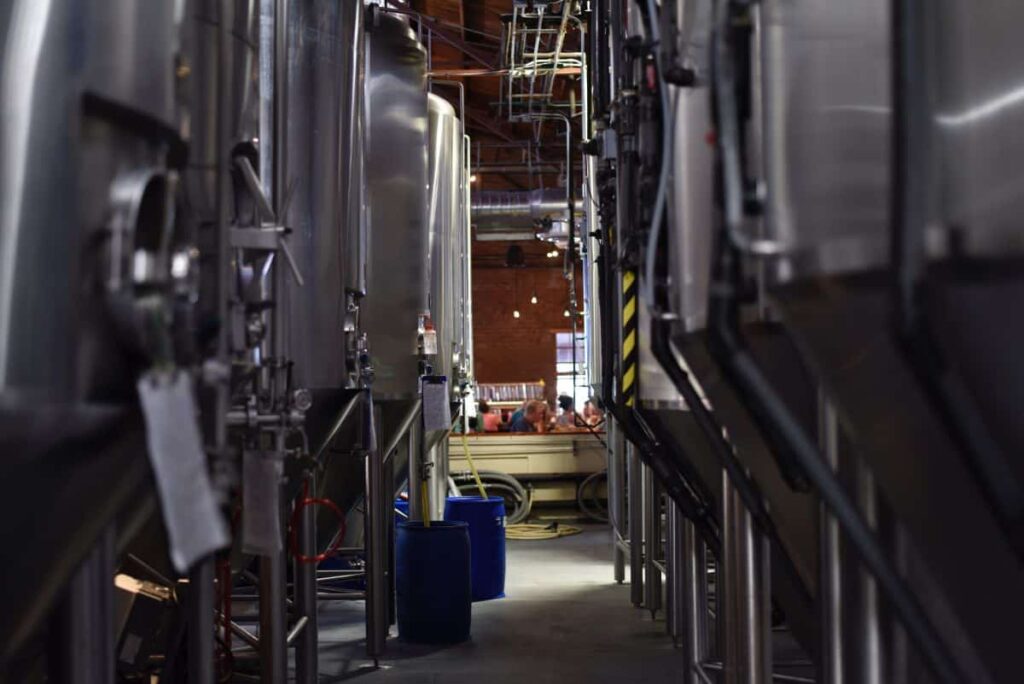
The importance of BOMs in process engineering design
Definition of BOMs and their meaning
BOMs (bills of material) are nothing more than summaries in which all the individual parts (and their required quantities) needed to manufacture a particular product are listed. They are an important organisational tool for ensuring the flow of materials in the manufacturing industry. As a rule, BOMs are tabular lists with corresponding items and sub-items.
Compilation of materials and components for the process
Although different industries use different approaches to creating BOMs, the most common format is organised from top to bottom. The end product is at the top, and the individual components are at the lower levels.
Integration of BOMs into the design process
The earlier the BOMs can be integrated into the design process, the better. Optimising processes and system design is naturally easier to implement at the planning stage than later during operation.
The use of tools and software solutions for design
Nowadays, computer-aided tools make the design of process engineering systems much easier. Many standardised elements from piping design can be incorporated “off the shelf” with powerful CAD solutions and adapted to individual requirements with little effort. However, due to the complexity of many process engineering systems, strict adherence to the correct sequence during design is crucial:
1. Creation of P&ID schemes
Piping and instrument diagrams are also known as P&ID diagrams. They are used to graphically visualise the structure and function of a system. They, therefore, represent the basic framework on which the subsequent system is based. All equipment and machines required for the processes are not shown to scale as simplified schematic illustrations or symbols.
2. 3D design
The outdated representation of pure 2D drawings often means that problems with the system design are only discovered during commissioning. However, thanks to modern CAD systems with 3D representation, all processes can be visualised on the computer in advance and tried in various configurations and spatial environments.
3. Produce pipework isometrics
Thanks to its simplified representation, the isometric drawing of a pipe provides a quick overview. Although the visualisation is simplified, it contains all dimensions and other relevant information required for the documentation and production of the pipeline.
4. Creation of BOMs
In principle, BOMs can be created using simple spreadsheet tools. Nowadays, however, it makes more sense to use dedicated tools that can be seamlessly integrated into CAD and other software solutions. This makes it much easier to import and export data.
Piping and instrumentation diagrams in the design of process plants
Importance of P&ID diagrams in process engineering
Creating piping and instrumentation diagrams (P&ID for short) is of great importance for process engineering, as they serve as an important reference for the planning phase. They are also crucial for documentation, which later serves as a reference for subsequent optimisations, conversions or modernisations of process engineering systems. In principle, P&ID diagrams illustrate the functional relationship between pipework, measuring equipment (instruments) and other components of the overall system. This also includes control and regulation technology as well as process automation measures.

Integration of pipework in P&ID diagrams
Suitable software can make the integration of pipework into P&ID diagrams can be made much easier. For example, process engineers can use special plant engineering software to convert P&ID diagrams into comprehensive 3D piping designs, which also includes automatic generation of piping isometrics. The same software can be used not only for P&ID creation, but also for the entire 3D design of pipelines.
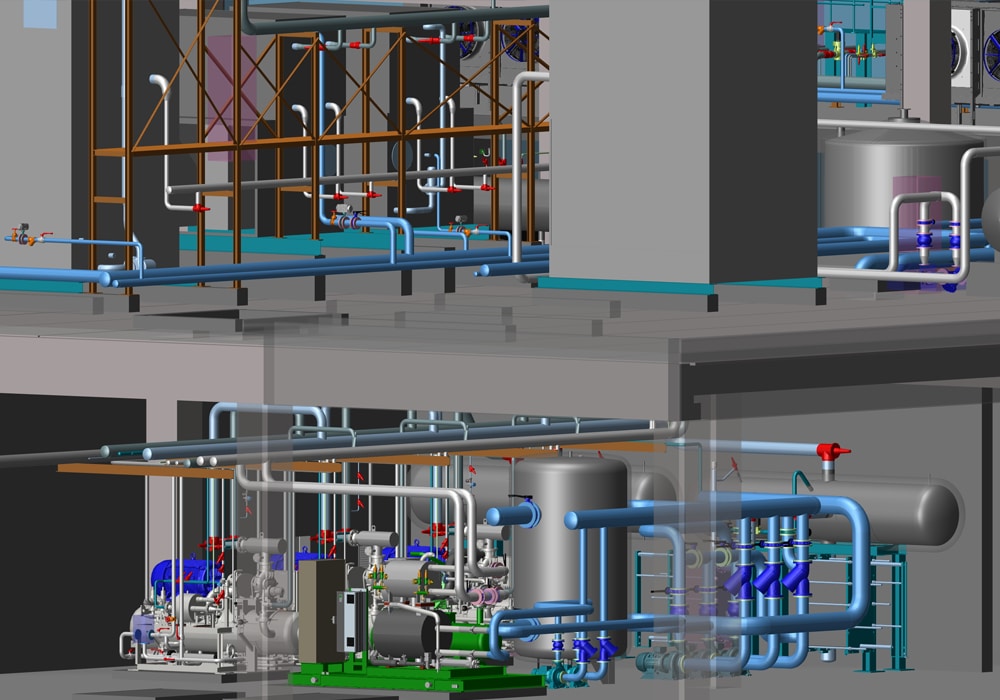
The M4 PLANT plant design system offers extremely high productivity through its wide range of specialised tools for design tasks such as piping layout, steelwork design and HVAC duct routing, all driven by extensive, and extensible, component libraries supplied with the software. M4 PLANT provides a flexible plant engineering solution regardless of project size. Its multi-user relational database approach provides a rules-based, specification-driven 3D design environment for all the major plant design disciplines, including P&ID driven process piping. It provides detailed engineering review capabilities as well as external 3D walk-through tools for project stakeholders.
Simply give us a call ( +49 2841 91840 )
or use our contact form
Main areas of process engineering
Stock separation and stock preparation
Various separation processes are used to separate substances that have already been mixed. Depending on the requirements and nature of the substances to be separated, different solutions are available that utilise the various physical and chemical properties of the substances in question. This area is among the most important basic process engineering functions. A distinction is made between different separation processes:
- Thermal separation processes (e.g. separation using boiling point, freezing point, sublimation) and separation based on the solubility of substances (e.g. washing)
- Mechanical separation processes (e.g. separation based on density, surface properties, particle size and/or particle inertia, magnetisability and electrostatic behaviour of materials)
- Chemical separation processes (e.g. etching, electrolysis, electrophoresis, roasting, zone melting processes)
Reaction engineering or chemical process engineering
Nowadays, many problems can be tackled primarily with reaction engineering. Whether in waste disposal, dealing with renewable energies or medical research – almost nothing works without reaction engineering. The design and conception of chemical reactors take centre stage. It begins with constructing test plants on a reduced scale to test the functionality and calculate the design. In particular, side reactions caused by external influences on the material reactions, such as pressure or temperature changes, must be considered. In addition, the time and energy balance must be calculated to estimate the profitability of the subsequent reactor. The majority of chemical reactions in industry (up to 80 %) are based on chemical catalysis. The catalyser ensures that a reaction gets going, accelerates or develops in a desired direction.
Process optimisation and control
Not everything that initially looks good in the design of a process engineering system also proves itself in the further course of the process. Depending on the specific requirements and the actual conditions, process control and possible process optimisation are essential. This also applies if a plant initially manages without optimisation, as new requirements or other changes almost always arise over time that need to be implemented (often during operation). Process optimisation is not an end in itself. It ensures more efficient processes and, therefore, a better cost balance. Energy benefits can often also be achieved, which benefits sustainability and environmental protection. Careful and continuous process control is the basis for any successful process optimisation.
The importance of pipework in process engineering
Function and significance of pipework
Pipelines can be found in almost all process engineering systems. They are suitable for transporting different types of substances. Gases and liquids can be transported in the same way as solids, whereby the transport capability depends on the properties and the transport system. For example, smaller particles can also be conveyed through pipes via air flow systems or bulk material by gravity. However, pipework is not only used to transport materials but also to feed or discharge auxiliary materials that are required for the reaction. This ranges from the supply or discharge of heat or cold to the transport of water and other auxiliary materials (e.g. chemicals for catalysis) and the disposal of waste and wastewater.
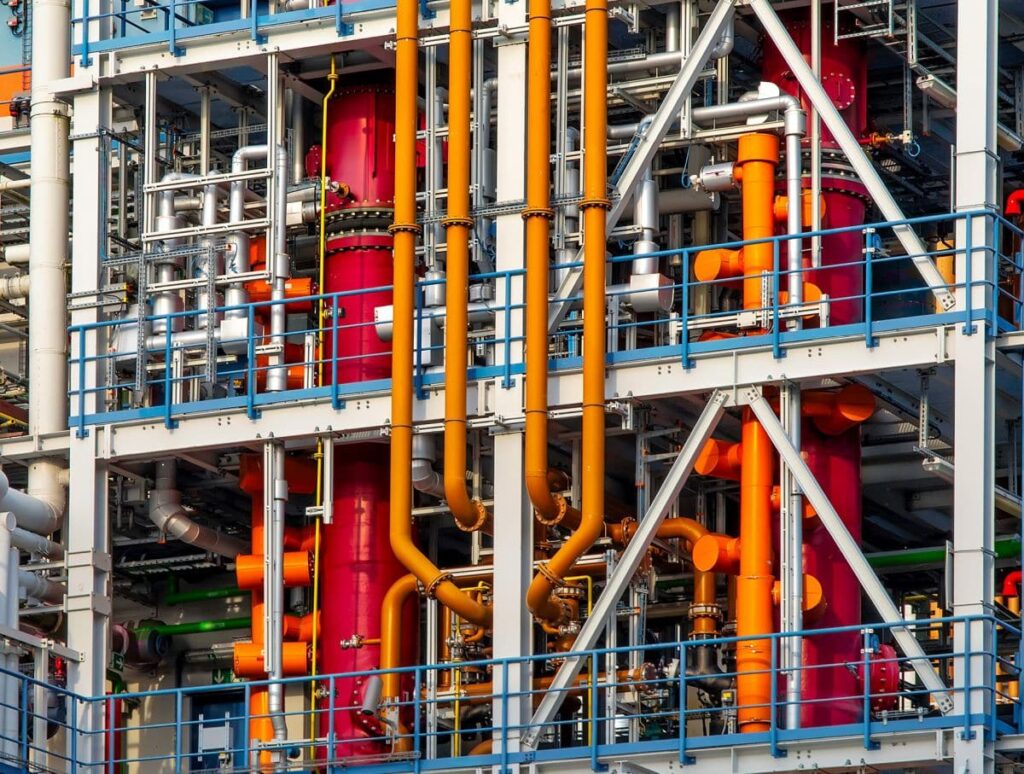
Selection of pipework materials and dimensions
Depending on their function, the pipes must, of course, be suitable for their task. This applies not only to the dimensions of the pipes (length, diameter, material thickness) but also to the material properties. For example, highly corrosive acids can only be transported in metal pipes to a limited extent, while acid-resistant plastics are less suitable for use at extremely high temperatures.
Calculation of pressure losses and flow properties
In addition, the inner walls of pipework have different flow characteristics, which can influence the processes depending on the area of application. Last but not least, the pressure loss must be considered, especially with longer pipework, which must be compensated for by additional pumps or other solutions.
The M4 PLANT plant design system offers extremely high productivity through its wide range of specialised tools for design tasks such as piping layout, steelwork design and HVAC duct routing, all driven by extensive, and extensible, component libraries supplied with the software. M4 PLANT provides a flexible plant engineering solution regardless of project size. Its multi-user relational database approach provides a rules-based, specification-driven 3D design environment for all the major plant design disciplines, including P&ID driven process piping. It provides detailed engineering review capabilities as well as external 3D walk-through tools for project stakeholders.
Simply give us a call ( +49 2841 91840 )
or use our contact form
Modern technologies in process engineering plants
Industry 4.0 and the digitalisation of process engineering
As we have already established, the old windmills of our ancestors were already process engineering systems. In principle, not much has changed in the design of such structures for centuries. However, the advent of digital technologies and the triumphant advance of so-called Industry 4.0 are placing new demands on the design and implementation of process engineering systems. At the same time, new possibilities are emerging, such as visualising facilities using virtual or augmented reality to save development costs. In this way, decision-makers and developers can, for example, take a digital tour of the hall where the plant will later be installed. It is particularly important to avoid mistakes when space is at a premium.

Automation and robotics in production
For example, if a system fits in the intended location without any problems on paper, it can happen in practice that the swivelling range is suddenly no longer sufficient due to the installation of another robot arm. By digitally simulating these scenarios in advance, valuable insights can be gained, allowing the prevention of errors from being built into the final system, ultimately saving time and money. Thanks to digital technology, it is also often possible to adapt to new conditions and requirements for process optimisation much more flexibly than before. Artificial intelligence will play a major role in process control and optimisation in the future.
Artificial intelligence and machine learning in process optimisation
The predictive detection of potential problems, including suggestions for optimisation and their subsequent implementation, are just the most obvious examples of the use of AI in process engineering systems. Machine learning will play a major role here. Material flow regulation, energy consumption and other factors can be conveniently and efficiently controlled using artificial intelligence. Automated systems and robotics are already part of everyday life, particularly in heavy industry and manufacturing. The integration and automation of such systems in the context of process engineering plants will become even more common.
Industries that regularly use process engineering
We have already established that process engineering systems are particularly in demand in the chemical industry, food, beverage and pharmaceutical production, as well as in energy and waste management. Here is a brief overview of possible areas of application:
- Chemical industry: Plants for the production of end products (e.g. plastic parts) or for the processing of intermediate materials required for the production of end products.
- Food industry: Food processing relies on fast, hygienic and reliable process technology. From the classic filling of drinks or tinned food to the processing and packaging of meat products and the sorting of fruit and vegetables, food producers cannot do without modern technology.
- Pharmaceutical industry: Similar to the chemical industry, process engineering systems for medical products almost always have to be designed from scratch. This begins with the manufacture of active ingredients and extends to the production of medical equipment and instruments.
- Energy and waste management: Whether coal-fired power plants, bioreactors or waste disposal plants, process engineering systems are always at the centre of attention. Sophisticated solutions for waste separation of complex materials and systems for utilising renewable energies are particularly in demand here.
Conclusion
Summary of the most important points
What began in the Stone Age with fire and continued with the separation of ore and metal has laid the foundations for process engineering systems. While large-scale industry used to be the main customer for such concepts, Industry 4.0, with its new possibilities, is also leading to changes in the work of process engineers. New opportunities always lead to new challenges. Process optimisation and process control are key aspects that are important not only during the planning phase. In fact, continuous optimisation of process engineering systems is essential for economical operation. However, challenges arise from the requirements for environmental protection, climate protection and energy consumption. Resource-saving development requires modern development tools. Digital technology plays a prominent role here, especially as the designing and realisation of process engineering systems have long been supported by computers and design software.
Outlook on the future significance and development of process engineering
Although new technologies such as AI and machine learning will change many aspects of process engineering implementation, other aspects will remain unchanged. For example, the need for pipework with a corresponding design environment will continue to exist in the future. Isometric representations and 3D environments in which developers and decision-makers can move freely offer a new approach to design and implementation before the plant is built. Many problems and obstacles that in the past often only became apparent after commissioning can be recognised and eliminated much more quickly using digital simulations and virtual reality. There is now no alternative to using good tools and powerful CAD software in the design of process plants.
FAQ – Process engineering
Process engineering is an area of engineering science that deals with the development, design and optimisation of processes that make chemical, physical or biological changes to materials. The aim is to convert raw materials into more valuable forms, for example in the production of plastics, medicines or food.
The most important areas of application for process engineering include the following industries: food, chemical, pharmaceutical, paper, textile, building materials, waste management, and metal processing.
In disciplinary terms, process engineering is part of mechanical engineering, as it utilises elements of manufacturing technology, energy technology and production technology to change form and/or convert energy.
Process engineering comprises various sub-disciplines, such as mechanical process engineering, thermal process engineering, chemical process engineering, bioprocess engineering and electrochemical process engineering.
Typical challenges in process engineering include scaling up laboratory processes to industrial production, optimising energy efficiency, minimising waste products and emissions, complying with strict regulatory requirements and adapting to changing raw material prices or availability.

